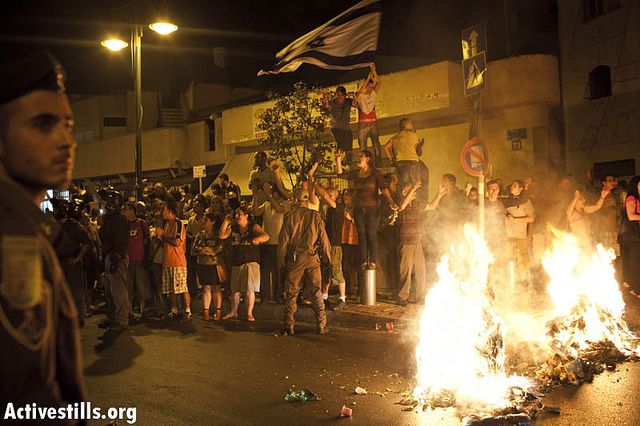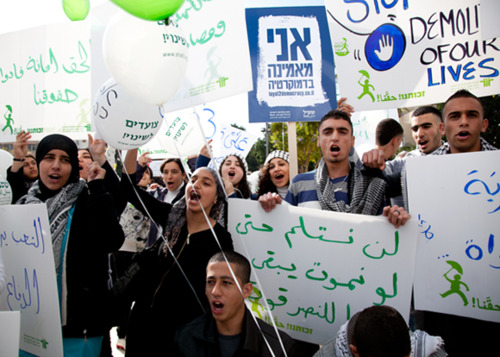0 notes &
Yes, in fact, I do know an Arab | Madeline E Sanderford
It is not unusual to grow up as an educated member of the white middle class of American society and believe that anywhere in the world, this privileged status will follow you. This is especially true when it comes to Israel, a country viewed by most American’s as a sort of 51st state, a country that welcomes American support, that aims to stay on America’s ‘good side.’ I abandoned this belief recently, however, when, for the first time in my life, I experienced what it was like to be a part of the minority, discriminated for something out of my control.

No my life was not threatened; I was not enslaved, deported or jailed. However, standing before three of El Al’s top security team answering for maybe the fifth time “why are you going to Israel?” I definitely received a wake up call.
It was during my return to Israel this January. I had been here in August for a fall semester with NYU in Tel Aviv, which was cut short in November when NYU chose to evacuate all 11 students for safety reasons following several days of rocket sirens. The experience began with my name being called over the intercom as I waited for my flight from Newark to Tel Aviv. I had asked to verify that my larger checked bag made it onto the plane, as I had not been given a baggage slip in the Richmond Airport when I left on my first flight the previous day. I assumed, incorrectly, that this was the reason, and so approached the counter where I was asked for my passport, which, also an incorrect assumption, I determined was for verifying the bag was in fact mine and that I was in fact me.
Harmless questions by the counter official turned into questions about a second passport and previous travel. Then backup arrived. The second security official asked me, in a different order, the same questions as the first. Eventually this series devolved into questions about what I was studying, why, and whether I knew any Arabs, to which I responded yes, as I am a student of Arabic and therefore, have an Arab Israeli, Palestinian professor, among other Arab professors and family friends. Of course they needed to know my professor’s name and when I had last contacted him. They then inquired into why I had studied Arabic as opposed to Hebrew (I am now studying both). I answered honestly, more people speak Arabic, and many Hebrew speakers also know some English. I am interested in the region so I thought it was the better choice. Wrong answer.
I was then led into the unmarked security room, referred to by those who have gotten to visit it as ‘the VIP room,’ which looks much like a dentist’s office. They took my bag to search it, disregarded the scissors I had forgotten and left in my make-up bag, and focused in on the Arabic vocabulary note cards and Arabic textbook I had in my carry-on. They then searched me for explosive residue, asked for proof of my acceptance to the NYU study away program, and verified where I would be living upon my arrival in Tel Aviv. Finally they took my phone, which they searched, packaged and checked under the plane.
I was then escorted to the gate where my documents were once again examined. I had in total been questioned by three male officials, and physically searched by two females, in a procedure that lasted about an hour and a half, ultimately delaying the flight. As the last person on the Israeli plane I, with my blonde hair and very American appearance, made quite the entrance to the flight otherwise almost exclusively Jewish. I arrived at my seat where the woman sharing my row leaned over to ask: “are you on a list?” It took me a moment to answer… “I don’t think so.”
When I arrived in Ben Gurion after 48 hours awake and travelling, I gathered my scattered belongings, and used a payphone to call my parents, trying as hard as I could to hold back tears.
My dad called the airline that day, and was assured by an El Al representative that they would certainly never have done such a thing.
It has taken me some time to digest this experience. I reflect on it now following a story in Haaretz about the potential for an airport security gaff during President Obama’s recent visit to sour relations.
While I highly doubt that Obama had the opportunity to experience this phenomenon, it is surely not unique to me, nor will it be the last time that it happens. Despite being the second official language of Israel, Arabic is certainly a red flag when it comes to security, something the Israelis are seemingly satisfied with, and something ACRI is trying to ensure does not remain unchallenged. While ACRI fights racism across every facet of Israeli society, this is one I am particularly proud of, as I have personally experienced this institutionalized phenomenon.
In a petition in 2012 against racial profiling in Israeli airports, ACRI contested the legality of considering ‘Arab’ an established and acceptable criterion for search, and while the State claimed meaningful changes were being made, this is not the case. In 2013, everyone from Arab school teachers and filmmakers to Arab Knesset party members have made headlines after having their rights severely violated by the Israeli security establishment. Additionally, it was confirmed by the Attorney General just this week, that despite inquiries from ACRI, the Shin Bet is allowed to, under any circumstances deemed relevant by them, demand access to private email accounts of foreigners attempting to visit Israel, and take their denial into account as a contributing factor to deny entry. These are just a few examples of the accepted discrimination and personal invasion allowed under “security measures.” As a result, ACRI diligently presses on.
This event for me, however, is about the bigger issue, not only the commonality of racial profiling and the invasion of personal privacy, but also the powerful undercurrent of racism pervasive within Israeli society, something I have continued to discover throughout my time at ACRI. Despite where I come from, I share with the Arabs in Israel and the Occupied Territories, the fact that I am not Jewish. With both the Arabs and the Jews, I share the fact that I am human. As ACRI president Sami Michael said recent at a conference entitled ‘Racism and the Education System in Israel,’ “there is no superior race, there is no inferior race, there is no pure race, and there is no impure race,” we are all a part of the ‘wonderful human race.’ With this in mind, it is time for the necessary self-reflection of the entire human community required to move towards a more peaceful future, void of harassment, intimidation, and racial discrimination; Israel clearly deserves to be at the forefront of this change.
Madeline E Sanderford | ACRI intern - Spring 2013

Madeline is a rising senior at New York University majoring in international politics with a concentration on Middle-Eastern and Islamic studies. With a passion for human rights, she sought out ACRI as a unique learning opportunity to supplement her junior year in Tel Aviv. A student of both Hebrew and Arabic, she hopes to one day aid in informing the conversation about American policy in this region.



 Jerusalem Day 2007 (photo: Wikimedia Commons)
Jerusalem Day 2007 (photo: Wikimedia Commons)


 Israel
Israel



 One of these small, manageable initiatives that I think is really worthwhile is the Tav Chevrati (Social Seal), established by the organization
One of these small, manageable initiatives that I think is really worthwhile is the Tav Chevrati (Social Seal), established by the organization  Jesse Rothman | ACRI intern in 2011/12
Jesse Rothman | ACRI intern in 2011/12


